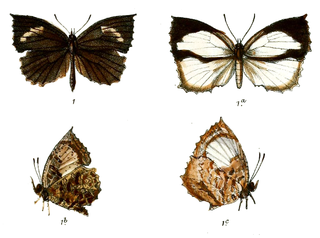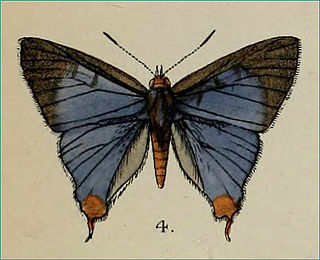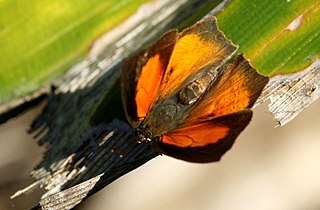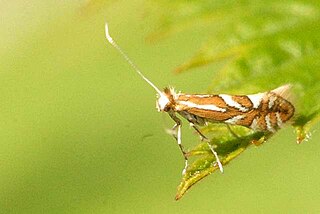
Zizula hylax, 'the Tiny grass blue' is a species of blue butterfly.

Allotinus drumila, the crenulate darkie, is a small butterfly found in India, Burma, Thailand, Laos, Vietnam, and Yunnan (China) that belongs to the lycaenids or blues family.

Cigaritis abnormis, the abnormal silverline, is a species of lycaenid or blue butterfly found in south India and Pakistan.

Zesius chrysomallus, the redspot, is a species of lycaenid or blue butterfly found in Sri Lanka and India.

Tajuria jehana, the plains blue royal, is a species of lycaenid or blue butterfly found in Asia.

Curetis acuta, the angled sunbeam, is a species of butterfly belong to the lycaenid family. It is found in Indomalayan realm. Curetis acuta is sexually dimorphic, the sexes differing in dorsal coloration of the wings, however their ventral wings are similar and of silver color which reflects sunlight. The reflection of light by silver ventral wings plays a role of signalling during flight, camouflage while at rest or during hibernation, and lowering body temperatures by reflecting the sunlight.

Anarta myrtilli, the beautiful yellow underwing, is a moth in the family Noctuidae. The species was first described by Carl Linnaeus in 1761. It is found in most of Europe including Scandinavia, Britain, France, Germany, Switzerland, Spain, Portugal, Italy, and Russia.

Phyllonorycter oxyacanthae is a moth of the family Gracillariidae. It is found in all of Europe except the Balkan Peninsula.

Hexadactilia trilobata is a moth of the family Pterophoridae described by Thomas Bainbrigge Fletcher in 1910. It is found in Australia in Queensland and New Guinea.

Cosmopterix inopis is a moth of the family Cosmopterigidae. It is known in the United States, from Arizona and Florida.
Zelosyne poecilosoma is a moth in the family Gelechiidae. It was described by Walsingham in 1911. It is found in Panama.
Megacraspedus astemphella is a moth of the family Gelechiidae. It was described by Edward Meyrick in 1904. It is found in Australia, where it has been recorded from Western Australia and South Australia.
Megacraspedus euxena is a moth of the family Gelechiidae. It was described by Edward Meyrick in 1904. It is found in Australia, where it has been recorded from Western Australia.
Megacraspedus hoplitis is a moth of the family Gelechiidae. It was described by Edward Meyrick in 1904. It is found in Australia, where it has been recorded from Western Australia.
Megacraspedus platyleuca is a moth of the family Gelechiidae. It was described by Edward Meyrick in 1904. It is found in Australia, where it has been recorded from New South Wales, Victoria, Tasmania and Western Australia.
Megacraspedus popularis is a moth of the family Gelechiidae. It was described by Edward Meyrick in 1904. It is found in Australia, where it has been recorded from New South Wales and Tasmania.
Megacraspedus tutti is a moth of the family Gelechiidae. It was described by Walsingham in 1887. It is found in France.
Megacraspedus sagittifera is a moth of the family Gelechiidae. It was described by Oswald Bertram Lower in 1900. It is found in Australia, where it has been recorded from New South Wales.
Megacraspedus stratimera is a moth of the family Gelechiidae. It was described by Oswald Bertram Lower in 1897. It is found in Australia, where it has been recorded from South Australia.
Ptocheuusa scholastica is a moth of the family Gelechiidae. It was described by Walsingham in 1903. It is found in Spain.








